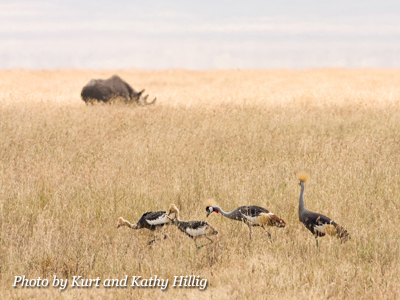Media Contacts: Kerryn Morrison, African Crane Conservation Programme Manager, International Crane Foundation / Endangered Wildlife Trust, Tel: +27 11 372 3600 / C + 27 82 877 5126; Lillian Mlambo, Communication and Brand Manager, Endangered Wildlife Trust, Tel: +27 11 372 3600
 Bonn, Germany – An International Species Action Plan for the Conservation of the Grey Crowned Crane has officially passed. The plan addresses the fact that Grey Crowned Cranes have undergone a long-term large scale population decline of up to 80% over the past 45 years, making it the fastest declining crane species in the world. The plan was endorsed at the 6th Session of the Meeting of the Parties to the Agreement on the Conservation of African-Eurasian Migratory Waterbirds (AEWA MOP6), held in Bonn, Germany from 9 – 14 November 2015.
Bonn, Germany – An International Species Action Plan for the Conservation of the Grey Crowned Crane has officially passed. The plan addresses the fact that Grey Crowned Cranes have undergone a long-term large scale population decline of up to 80% over the past 45 years, making it the fastest declining crane species in the world. The plan was endorsed at the 6th Session of the Meeting of the Parties to the Agreement on the Conservation of African-Eurasian Migratory Waterbirds (AEWA MOP6), held in Bonn, Germany from 9 – 14 November 2015.
Grey Crowned Cranes are threatened by habitat loss, illegal captive trade, human and livestock disturbance, poisoning, power line collisions, and electrocutions. This Plan provides a roadmap for what is required to stabilize and improve the current situation for the population across its distribution, including actions to:
• Reduce adult and juvenile mortality and loss of birds;
• Increase breeding success and reproductive rates;
• Reduce significantly further loss, fragmentation, and degradation of habitats;
• Fill key knowledge gaps about Grey Crowned Cranes.
“Grey Crowned Cranes are iconic, charismatic flagships for Southern and East Africa’s grasslands and wetlands. We are proud that South Africa has the only sustainable and increasing population in Africa, but in order to secure a future for the entire species, we need governments to acknowledge the current dire situation, and to commit to efforts to resolve this,” said Kerryn Morrison, International Crane Foundation / Endangered Wildlife Trust Partnership Manager: African Crane Conservation Programme.
Click here to view an interview with Kerryn about the International Species Action Plan.
The newly adopted plan provides the opportunity for a multi-disciplinary and multi-stakeholder coordinated approach that incorporates government, species experts, NGO’s, research institutions and the private sector. Although only Burundi, Kenya, Rwanda, South Africa, Tanzania, Uganda, and Zimbabwe are signatories to this multilateral agreement, the Plan has incorporated all countries across the species’ range.
###
Background on AEWA
The Agreement on the Conservation of African-Eurasian Migratory Waterbirds (AEWA) is an intergovernmental treaty dedicated to the conservation of migratory waterbirds and their habitats across Africa, Europe, the Middle East, Central Asia, Greenland and the Canadian Archipelago.
Developed under the framework of the Convention on Migratory Species (CMS) and administered by the United Nations Environment Programme (UNEP), AEWA brings together countries and the wider international conservation community in an effort to establish coordinated conservation and management of migratory waterbirds throughout their entire migratory range.
The Agreement area stretches from the northern reaches of Canada and the Russian Federation to the southernmost tip of Africa, covering 119 Range States from Europe, parts of Asia and Canada, the Middle East and Africa. Currently 74 countries and the European Union (EU) have become a Contracting Party to AEWA (as of 1 May 2015).
The Agreement provides for coordinated and concerted action to be taken by the Range States throughout the migration system of waterbirds to which it applies.
The development of the plan
Under the African Eurasian Migratory Waterbird Agreement (AEWA). The draft International Single Species Action Plan (ISSAP) for the Conservation of the Grey Crowned Crane (Balearica regulorum) was commissioned to the International Crane Foundation / Endangered Wildlife Trust Partnership and was compiled by Kerryn Morrison. The action planning process was financially supported by the Federal Office for the Environment in Switzerland, The Nature and Biodiversity Conservation Union – NABU, Dohmen Family Foundation and Kölner Zoo. Drafts of the plan went through rigorous consultations with experts, followed by official consultation with government officials in the range states. The draft plan was approved for submission to MOP6 by the Technical Committee at its 12th Meeting in March 2015 and the Standing Committee at its 10th Meeting in July 2015.
The International Crane Foundation works worldwide to conserve cranes
and the ecosystems, watersheds, and flyways on which they depend.
The Endangered Wildlife Trust is dedicated to conserving
threatened species and ecosystems in southern Africa to the benefit of all people.
